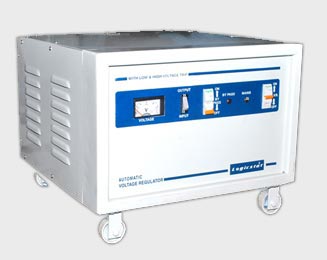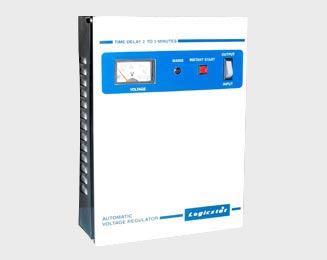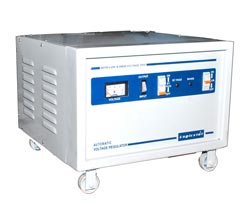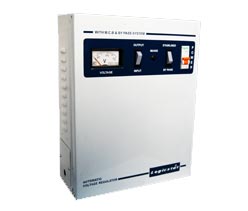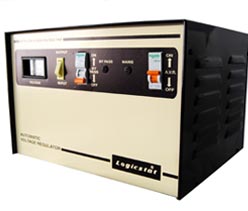
Automatic Voltage Regulators
AVR's save on the cost associated with equipment damage caused by poor voltage levels. We manufacture best-in-class copper winding automatic stabilizer in wide input range
Key features
- Electronic circuitry is zener controlled.
- Only IC, silicon transistors are used for reliability at high temperatures.
- High quality electromagnetic relays are used which operate silently without producing thumping sound during voltage fluctuations.
- Stability with temperature changes.
- Safe at an ambient temperature from 10 degrees to 50 degrees Centigrade.
- Wide input range.
- Outer cabinet stove enameled after proper anti rust phosphate process.
- Low/High tripping facility and Time Delay Relay provided at an extra cost.
- All transformers are vacuum impregnated with high class varnish for reliability and long life.
- All AVR's designed by us comply with the latest safety codes of practice
Specifications
| INPUT VOLTAGE RANGE | OUTPUT VOLTAGE RANGE | CAPACITY |
|---|---|---|
| 180 -270 Volts | 200 -240 Volts | 0.25 – 10 KVA |
| 145-280 Volts | 200 -240 Volts | 0.25 – 10 KVA |
| 110-280 Volts | 200 -240 Volts | 0.25 – 10 KVA |
| 90-240 Volts | 200 -240 Volts | 0.25 – 5 KVA |
Note: An output/input switch is provided on every stabilizer. Press this to ascertain input voltage at any time. This will not interfere with the working of your stabilizer. A pilot lamp indicates that the stabilizer is in operation. This switch should normally be kept on the output side.
SELECTION GUIDE/APPLICATION
As both high and low mains voltage can damage your electrical equipment, the Logicstat AVR is designed to monitor and correct incoming supply continuously. If the voltage rises or drops, the AVR will stabilize the output to ensure that the voltage reaching your equipment remains within the operating range of the unit. The AVR also protects your electrical equipments against voltage fluctuations. By using the AVR you will ensure a stable and clean voltage supply to your equipment. Depending on the rating of your AVR, it is suitable for all electrical and electronic appliances, including: Fridges, Photocopiers, Laser Printers, Coolers, Televisions, Satellite Equipment, Computers, Fax machines, Air Conditioners, Video Equipment, Domestic pumps
CAUTION
- Follow safety instructions while installing and operating them.
- To avoid the risk of shock do not expose the AVR to rain, moisture or liquid spillage.
- Before attempting to use the AVR ensure that the total loading of your stabilizer does not exceed the maximum rating of the AVR. If in doubt consult your electrician.
- Do not insert any object into the ventilation slot.
- Do not install AVR's inside closed cupboards and do not allow papers or other materials to be piled on top.
- Do not attempt to dismantle the AVR .Doing so will invalidate the guarantee.
Some Of Our Clients
 |
 |
 |
 |
 |
 |
 |
 |
 |
 |
 |

